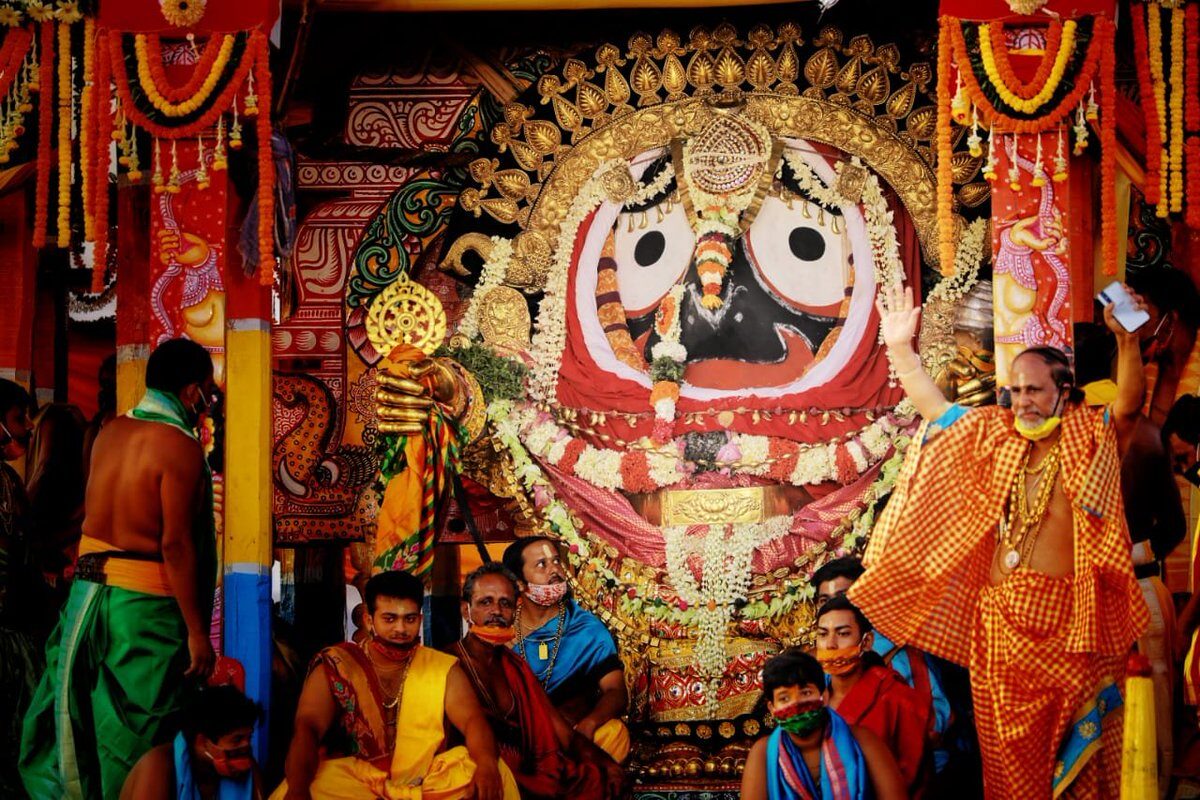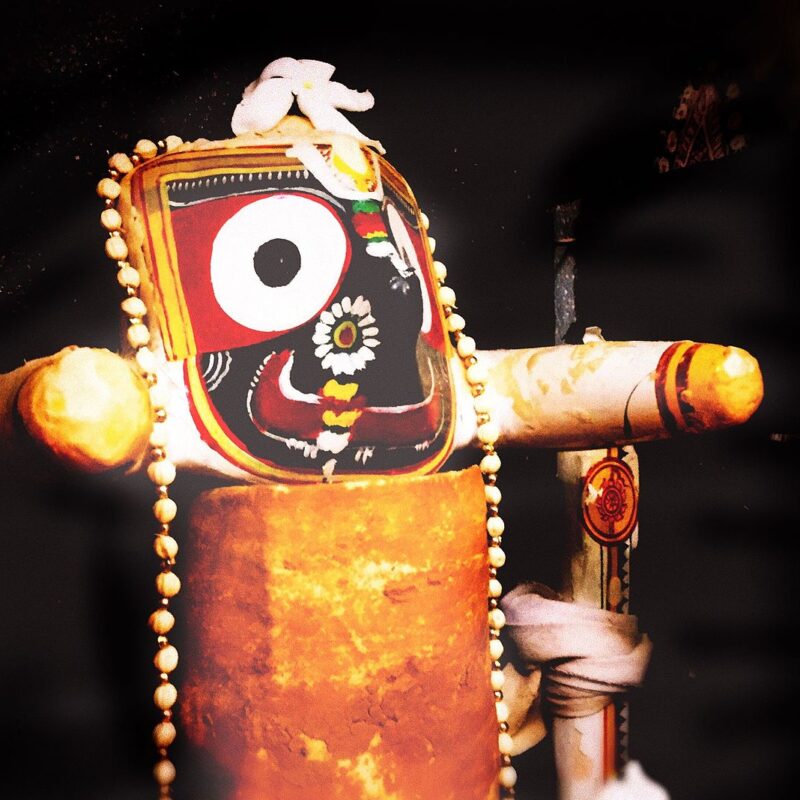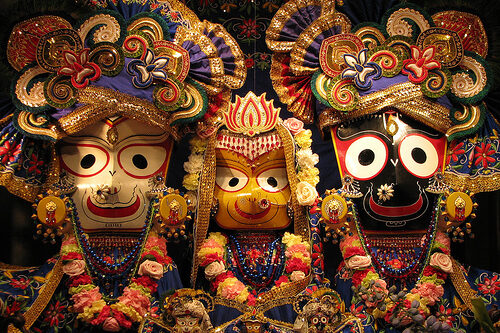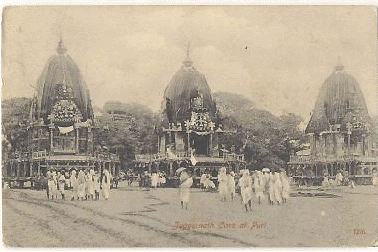
Sometime after the installation, in the early part of April, the Swami called Shyamasundar to his room, handing him a drawing of what looked like some sort of wagon. Once every year, he told him, the Jagannatha, Baladeva, and Subhadra deities in Orissa are taken from the temple and each placed on raths, or huge wooden carts, and pushed and pulled by celebrants — numbering more than a million — to the beach where they have a vacation for a week before returning to the temple.
An ancient tradition that allows the deities to be more widely viewed and appreciated by the public, the ceremony also holds a deeper meaning, representing a pastime believed to have taken place roughly 5,000 years ago, when Krishna was actually living on the earth.
Raised as a cowherd boy in a village called Vrindavan, Krishna eventually moved to the city where he took on the responsibilities of a king. Though externally he fulfilled his sovereign duties amidst the opulence and splendor that accompany royal life, his thoughts never strayed from his family and friends in Vrindavan, whose immense love for him far exceeded any sort of wealth he encountered as a ruler.
Once, upon hearing of their devotion, and the immense perpetual heartbreak they had been engulfed in since his departure, Krishna became so overwhelmed by his own heartache and profound feelings of love, he underwent an extraordinary physical reaction, as his eyes grew large with tears, his smile stretched long across his face, and his arms and legs contracted into his body, plunging him into an indescribable state of ecstasy.
A pastime, therefore, fueled by Krishna’s desire to reunite with the people of Vrindavan, the Ratha Yatra tradition symbolizes his return — accompanied by his siblings — to his home, making the festival an exceptionally exultant one, and why Jagannatha is deemed an exceptionally soft-hearted and munificent form.
It would be too much to build a large cart for each deity, the Swami said, especially considering the festival customarily takes place in late June or early July, which was only a few months away. But if they did something simpler, like carry all three on the back of a truck, then the San Francisco devotees too would be able to observe the festival, even if in a more rudimentary fashion.
Excited to help fulfill yet another vision of his guru’s, Shyamasundar wasted no time in meeting with several other devotees, as they began making plans for the event. Though, to their despondency, the Swami was due to leave for New York on April 9, where another temple and community of devotees were eagerly awaiting to have his association, he promised he would come back to San Francisco in time for Ratha Yatra.
Hence motivated to organize a festival worthy of their spiritual teacher’s return, the devotees began divvying up the tasks. Obtaining the necessary permits, printing posters, acquiring a sound system, and collecting food donations so there could be several days of feasting at the temple for the festival as instructed by the Swami, they poured their energy into making the event a reality. Even if the Swami wasn’t with them at the moment, they felt close to him when carrying out his wishes, and exuberant at the thought of when he would finally be with them again.
Such exuberance, however, became darkened by a cloud of concern when, during the last weeks of May, rumors began trickling in from the devotees in New York that the Swami was ill. And when on June 1 they received a phone call saying he had had a major stroke and was at the hospital in critical condition, this cloud turned into an all-out storm of anxiety.
A ragtag group of seekers who had become disenchanted by a life centered around the futile endeavor of sensual pursuit, the Swami had shown them a different path, filled with love, connection, and adventure in selfless service. Having seen this path, they could not return to their old life. At the same time, they still felt very much like spiritual novices, unable to imagine the idea of treading this new course without his guidance.
Rushing to the temple, they held an all-night kirtan, praying fervently to Krishna their guru would survive, until around 8 a.m., when the phone rang, and they all fell into an abrupt silence.
Walking to the back of the room, Shyamasundar picked up the receiver. It was a devotee from New York named Gargamuni. The Swami had made it through the night, he promptly told him. He was still in critical condition, according to the doctor, and would have to remain in the hospital for a while, but he was going to be ok.
There was a collective sigh of relief when Shyamasundar delivered the news to the others, and an utter feeling of joy when a letter from the Swami arrived a few days later, thanking them for their prayers. And when yet another letter arrived a few days after that, informing them he was slowly getting better and that he planned to return in time for Ratha Yatra, a feeling of total disbelief swept over them.

Photo by Gurudas
How could he be thinking of Ratha Yatra so soon after almost dying? As inconceivable as it seemed, it was all the more inspiring. Though their planning for the festival had been all but forgotten amidst the turbulence of the Swami’s stroke, his determination, along with his anticipated return, charged the devotees with renewed enthusiasm.
Redoubling their efforts, they dove back into preparing for the event.
One of the major driving forces behind the festival, Shyamasundar, with the help of another devotee named Jayananda, who also had carpentry skills, went to work on manufacturing something that would resemble a rath cart. Following a sketch the Swami had given them, they constructed a deck and pyramid-shaped canopy on the back of a 20-foot open sided flatbed truck. While the 8 feet at the rear would be for the deities, the remaining 12-foot section would be open for devotees to ride along and perform kirtan.
As preparations continued to pick up steam, the Swami arrived in San Francisco roughly a week before the Ratha Yatra was scheduled to take place. Looking a little tired, but beaming and as radiant as ever, he was greeted to a most joyous and rousing welcome, the devotees rejoiced to once again be in the presence of their beloved spiritual father and mentor.
Helping him settle into the beachfront house they had rented for him outside of the city in Paradisio, Stinson Beach, where he could have the necessary peace and quiet needed for him to continue his recovery during his stay, they resumed their planning, passing out thousands of leaflets, plastering posters all over town, and gathering food and flowers.
When Ratha Yatra day finally arrived, Shyamasundar, after frantically putting the finishing touches on the rath truck, pulled up to Page Street with the deities, where the procession was scheduled to take place. As kirtan blared through speakers to a crowd of hundreds, the cops diverted traffic, signaling that it was time for the parade to start moving.
Though the swami was still too weak to actually participate in the festivities, the fact that he was in San Francisco with them was more than they could have hoped for. Even if he couldn’t be with them during the procession, maybe they could bring Jagannatha to him after.

Photo by Gurudas
And so with Baladeva facing left (the driver’s side), Subhadra facing straight out back, and Jagannatha facing right (the passenger side), the deities — accompanied on the flatbed by 10 or so devotees — looked upon the crowd, as Shyamasundar popped the clutch and slowly began climbing up the hill the street ran on.
A precarious ascent in which the truck was surrounded by dancing people, running kids, and scurrying dogs, Shyamasundar kept having to push in the clutch and hit the brakes until, halfway up the hill, he was late with the clutch and the engine stalled.
Feverishly attempting to get the truck moving again, he became deluged in panic when it did begin moving, but backwards, rolling — with the deities, sound equipment, and huge load of devotees — about six feet, until there was a thump sound. Terrified he had hit someone, he continued to frantically turn the key, until the engine finally restarted, he stepped on the accelerator, and the truck moved forward again to the cheering of all. Fortunately, Mukunda said, jumping into the cab with him, no one was hurt. It was only a pothole.
Relieved, Shyamasundar continued climbing up the hill, until the procession finally reached the finishing point at Ocean Beach, where they triumphantly did several hours of kirtan.
When the singing eventually came to an end, a bunch of the devotees piled onto the back of the truck and he began driving them to where the Swami was staying. Though a 25-mile journey through a dark, cold, and windy night, in which they had to hold on for dear life as Shyamasundar navigated the precipitous winding roads, the eagerness to tell their guru about the festival was enough to abate their fear.
Describing their arrival in his book, Shyamasundar writes:
When we got to the Paradisio house, the Swami greeted us in a jolly mood, like his children coming home from the war. Everyone cried tears of joy. We described our adventures of the day, and he said ours had the same tone of madness, near-accident, and jubilation as the sacred Ratha Yatra festivals in India. “Yes, in Puri sometimes the cart will roll backward, and only with great effort can they make it move. Krishna enjoys this sporting adventure, seeing his devotees cry out for him.”

Elated to hear his enthusiastic words, the devotees offloaded the deities at the swami’s house where they would remain for a few days’ vacation, and then returned home, exhilarated by the day’s events. San Francisco Ratha Yatra — the first Ratha Yatra ever to be held outside of India — while obviously rough around the edges, had pleased their guru, and had therefore felt like a glorious and resounding success.
Though, in a few weeks time, the Swami would leave them once again, this time for India, where he could get the Ayurvedic treatment he wanted to help him complete his recovery, his impending departure felt different than the last.
Yes, they would miss him sorely, as they always would in his absence, but the festival had taught them that as long as they continued to serve Jagannatha with love and enthusiasm, they would always feel near to the Swami, no matter how far from them he went.
Thus ends the second and final part of “How Jagannatha’s discovery in a store led to America’s first ever Ratha Yatra. If you enjoyed this series, then you may also be interested in “Who was that Hare Krishna at the start of ‘Get Back'”
And if you’d like to learn more about the history of the Hare Krishna’s and ISKCON, you can order all three volumes of Shyamasundar’s “Chasing Rhinos with The Swami” at Chasingrhinos.com.










































